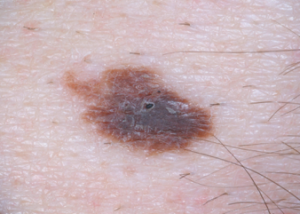
A dermatologist provides the information you really need to know about moles that grow larger, develop an irregular shape and become multi-colored.
Certainly, you may already know that suspicious signs of melanoma are changes in a mole that include an increase in size, an evolving irregularity to its shape, and the formation of new colors.
Mole Is Bigger, Irregular, Has Different Colors
I once read in a melanoma-anxiety forum that a person noticed that his mole had gotten a bit bigger, had become irregular (he used that term — but didn’t really specify beyond that), and also became multi-colored (his wording again).
He said he feared melanoma and had it biopsied.
The result was benign. He didn’t say anything else, such as whether or not his doctor explained how these features could have changed yet the mole was still benign.
“While these worrisome features can frequently signify skin cancer, this is fortunately not always the case!” begins Dr. Rebecca Tung, MD, a
“Some medications can cause sun sensitivity leading to further pigmentation (color change) in lesions such as moles and freckles, yet do not cause cancerous change.
“Irregular shaped pigmented lesions may actually be freckles rather than moles.
“A biopsy of mole can be viewed under the microscope for a definitive answer.
“Typically, the microscopic features that identify skin cancer are very distinct from benign moles.”
A Biopsy Won’t Lie

You should always request a biopsy from your dematologist.
It is really no big deal because there is minimal discomfort.
During the procedure, a small sample of the mole or skin is removed for examination under a microscope.
Local anesthesia is applied to numb the area, so most patients feel only a minor pinch or pressure.
After the biopsy, you may experience slight soreness or tenderness at the site, but this typically resolves quickly.
The procedure is quick, and most people can resume normal activities shortly after.
Though waiting for the results means a lot of anxiety, this surely beats a situation of never-ending wondering because you didn’t have the biopsy for that odd looking mole with more than a few colors.
NOTE: When any mole is removed, regardless of the reason, it should always be biopsied.
Dr. Tung’s specialties include general dermatology with skin cancer surveillance, moles, melanoma, surgery (Mohs micrographic, laser, skin cancer reconstruction) and cosmetic dermatology.
specialties include general dermatology with skin cancer surveillance, moles, melanoma, surgery (Mohs micrographic, laser, skin cancer reconstruction) and cosmetic dermatology.
 Lorra Garrick has been covering medical, fitness and cybersecurity topics for many years, having written thousands of articles for print magazines and websites, including as a ghostwriter. She’s also a former ACE-certified personal trainer.
Lorra Garrick has been covering medical, fitness and cybersecurity topics for many years, having written thousands of articles for print magazines and websites, including as a ghostwriter. She’s also a former ACE-certified personal trainer.
.









































